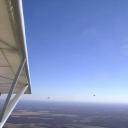Yahoo Answers is shutting down on May 4th, 2021 (Eastern Time) and the Yahoo Answers website is now in read-only mode. There will be no changes to other Yahoo properties or services, or your Yahoo account. You can find more information about the Yahoo Answers shutdown and how to download your data on this help page.
Trending News
Why is it that afternoon cumulus clouds have flat bottoms all at the same altitude, for miles around?
7 Answers
- TQLv 77 years agoFavorite Answer
The surface air temperature is about the same over broad areas. Same can be same about the dew point temperature.
The process starts when the thermal updrafts are created by the sun heating the ground. The air temperature cools at the rate of 5.5°F / 1000' and the dew point temperature cools at the rate of 1°F / 1000'. At some point, the two temperatures become equal at which point the relative humidity is 100% and a cumulus cloud is born.
The cloud heights are essentially the same because the surface air temperatures are fairly uniform as are the dew points.
 Source(s): National Weather Service meteorologist
Source(s): National Weather Service meteorologist - Mr. SmartypantsLv 77 years ago
Joseph is right. It has to do with something called the Lapse Rate. That is the rate that temperature drops as you gain altitude. If you were to leave the ground and rise up into sky by magic, you'd find that for every 1000 feet the air got colder by roughly 3.5 degrees F.
Well you probably also know that the colder air is, the less humidity it can hold. (Also as you go higher atmospheric pressure decreases, and that has an effect on how much water the air can hold). So at a certain point the air becomes 'supersaturated', that is, it can't hold the humidity it already has. So the water comes out as tiny droplets of liquid water, i.e. a cloud. That point is the bottom of the cloud layer
- Michel VerheugheLv 77 years ago
Excellent answers from Joseph and Smartypants. In aviation, we do this: we read the ambient and dew point temperatures from the METAR (aviation weather report) and we subtract them. The difference is called, the spread. We multiply that by 500 (centigrades, in Europe) or 300 (Farenheit in the US) and we get the altitude at which the cloud base can be expected, in feet (pilots use feet worldwide). For example if the temperature is 15C and the dew point is 11C the spread is 4C and the cloud base can be expected to be at 2,000 ft above ground level.
- 7 years ago
Because THAT is the Altitude where the Dew Point & the Temperature are the Same- and Condensation Occurs. :)
Source(s): Me; a Weather Buff. - Anonymous5 years ago
Wow you're a stupid fcking *****. Pretend to be a mother and tell people all about how to write scholarly papers yet you're too stupid to pass a BASIC 7th grade science class. That and you're supposedly a mother? Yeah another trashy teen mom with a mistake you should have aborted who'll grow up to be uneducated trash on welfare asking for help on childrens homework into adulthood, hahaha. Did you get held back dummy?
- Anonymous7 years ago
clouds are cold, so water forms, creating cloud.




